Anatomical Illustration
The Phenomenon of Phrenology
The basic idea upon which phrenology rests is that the form of the head represents the form of the brain and thus reflects the brain's relative development. The Austrian physician Franz Joseph Gall—very much interested in the works on physiognomy by the Italian Renaissance scholar Giambattista Della Porta—formulated his phrenologic theory at the end of the eighteenth century.
At the beginning of the nineteenth century interest in phrenology grew rapidly. People used the advice of phrenologists for all sorts of things, including the diagnosis of mental illness or psychological afflictions. Phrenology seriously attracted the likes of G. W. F. Hegel, Honoré de Balzac, the Brontë sisters, George Eliot, James Garfield, Thomas Edison, Walt Whitman, and Queen Victoria.
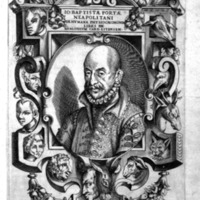
Giambattista della Porta
La Fisonomia Dell' Hvomo, Et La Celeste.
Venice: Nicolò Pezzana, 1668.
Giambattista della Porta was one of the most distinguished Italian Renaissance scholars. His works encompassed such subjects as astrology, alchemy, cryptology, and natural magic, and they had an irrefutable influence on Caspar Lavater as well as the phrenologists of the nineteenth century.
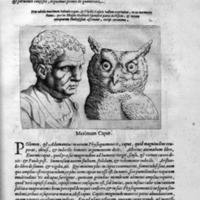
Giambattista della Porta
De Hvmana Physiognomonia, Libri III.
Vico Equense: Josephus Cacchius, 1586.
In La Fisonomia dell'Huomo, della Porta defines physiognomy (fisonomia) as a science that investigates natural tendencies or traits of human nature based on fixed features of the body. In his books he used woodcuts of animals to illustrate human characteristics and argued that it is a person's temperament and not the stars that influences facial features, general appearance, and character.
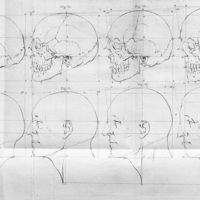
Petrus Camper was a Dutch physician, naturalist, anthropologist, paleontologist, sculptor, and patron of the arts. His fame rests on the invention of the facial angle: the degree of protrusion of the lower face.
He tried to classify human races according to their geographical origin. Camper also believed that we could decipher people's characters by measuring their faces.
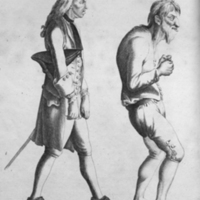
Johann Caspar Lavater.
Physiognomik.
Vienna: J.P. Sollinger, 1829.
Johann Caspar Lavater was a minor Swiss poet, writer, polemist, and proponent of physiognomy. A Protestant pastor, Lavater believed in the interaction of mind and body, which led him to the opinion that spirit influenced man's physical features.
Though almost forgotten nowadays, he gained a European renown by creating a theory that attempted to explain human character through physical appearance. Lavater had significant influence on his contemporary, Franz Joseph Gall.

While Orson Squire Fowler was studying to be a minister at Amherst College, Johann Gaspar Spurzheim gave a series of well-received lectures in Boston, and word of the new theory of phrenology had made its way to Western Massachusetts. Fowler quickly devoured all the information on the new science that he could, and he and his brother Lorenzo Niles Fowler eventually became the most important figures in the movement in America.
The brothers began publishing the American Phrenological Journal and Miscellany in 1838, and practiced their trade in cities around New England, settling eventually in New York City in 1842. They opened a publishing house and authored and published many books and pamphlets on phrenology. They helped to popularize the science by emphasizing its self-improvement aspect—a person could improve on the characteristics he was lacking—and by applying it to practical matters, such as marriage and choosing a career. As practitioners, the two performed phrenological examinations on many famous heads of their time, including Henry Ward Beecher, Brigham Young, Walt Whitman, John Brown, Mark Twain, and Clara Barton.
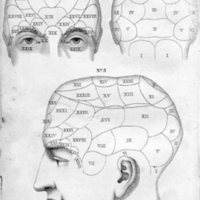
Franz Joseph Gall and his assistant Johann Gaspar Spurzheim are the fathers of the science of phrenology. Gall began developing his theories in late eighteenth-century Vienna, where he observed that similar abilities seemed to correspond with certain physiological characteristics of the skull. Spurzheim further developed Gall's ideas and helped spread the science with his lectures and presentations in England, Scotland, and the United States.
This anonymously published guide to the basics of phrenology was printed in Edinburgh, and may be the work of George Combe. Combe was a Scottish lawyer who, though skeptical of phrenology at first, became a convert after seeing Spruzheim give a series of lectures in Edinburgh. Combe went on to assist in founding the Phrenological Society of Edinburgh in 1820. Following in Spurzheim's footsteps, Combe helped popularize the science by lecturing throughout Britain, the United States, and Europe.
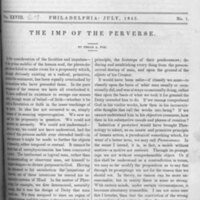
Edgar Allan Poe was one of many nineteenth-century authors who took an interest in phrenology. The prevalence of the science in British and American culture meant that contemporary readers of his work would understand any phrenological references he made. Walt Whitman, Charlotte Brontë, Herman Melville, Charles Dickens, George Eliot, and Mark Twain, among others, all used phrenology in their writing, both seriously and to humorous effect. Many of these writers even submitted to phrenological examinations at some point, including Whitman, who had the results of his exam published multiple times.
Shown here in its first published appearance, "The Imp of the Perverse" criticizes the omission of perversity from the phrenological classification of organs. The science is invoked both explicitly and implicitly in other Poe works. The vivid description of characters is often conveyed through specific phrenological traits, such as Roderick Usher in "The Fall of the House of Usher."
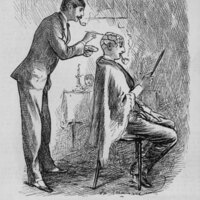
Punch Magazine.
Volume 74.
London: Punch Publications, 1878.
The science of phrenology took hold early in the nineteenth century, mainly in Britain and the United States. By the middle of the century, phrenology had become quite popular, often being practiced by amateurs with the aid of guide books and phrenological busts. These busts, which depicted the location of the various "organs" of the brain, became popular images, appearing on all kinds of objects, including ink wells, snuff boxes, and cane handles.
Phrenology's popularity made it an easy target for humorists. Punch, one of the most popular Victorian humor magazines, was no exception. In the issue on display, a cartoon suggests a new idea for a costume ball: "Shave your head and go as a phrenological bust."

Cesare Lombroso
The Female Offender.
New York: D. Appleton and Company, 1909.
Cesare Lombroso was the founder of the Italian school of Positivist Criminology, drawing inspiration from the works of Franz Joseph Gall. Lombroso argued that a criminal mind is inherited and could be identified by physical defects.
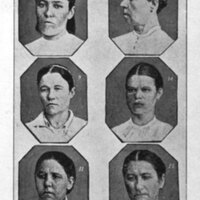
Cesare Lombroso.
The Female Offender.
New York: D. Appleton and Company, 1909.
For the past century phrenology has been seen as a "pseudo-science" at best and a punch line at worst, but recently some scientists have been reexamining the role of phrenology as a precursor to a number of reputable practices today, such as criminology and brain scanning and imaging. Coming at the end of the Enlightenment, phrenology sought for a scientific way to explain human actions and personalities rather than simply labeling all antisocial behavior as sin. In addition to advocating treating criminals rather than simply condemning them, phrenologists joined the call for abolition of capital punishment.

Marmaduke Blake Sampson, chairman of the Tontine and Homeopathic Associations of Great Britain, was a very eloquent and passionate advocate of the treatment of criminals according to phrenological theory. The editors of the Phrenological Journal extolled him as "a most valuable accession to the band of phrenological advocates of sound criminal jurisprudence" (1842).
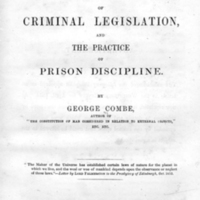
George Combe was one of the most influential figures in phrenology. The Scottish lawyer classified men based on the relative sizes of their moral/intellectual brain "organs" and their "propensities," that is, the faculties that controlled their lower impulses. He argued for reformation of criminals over punishment, believing that the size of the "organs" could be altered with proper training.